The Executioner, The Executioner 2: Karate Inferno (1974)
Directed by: Teruo Ishii
Written by: Shinichi Hashimoto, Teruo Ishii
Starring: Eiji Gô, Makoto Sato, Masahiko Tsagawa, Ryô Ikebe, Sonny Chiba, Yukata Nakajima
JAPAN
THE EXECUTIONER COLLECTION [THE EXECUTIONER, THE EXECUTIONER: KARATE INFERNO [1974]
AVAILABLE ON BLU-RAY: NOW, from ARROW VIDEO
REVIEWED BY: Dr Lenera
Was Sonny Chiba Japan’s greatest martial arts movie star? There are many who think so, while I haven’t seen anywhere near enough of his films to judge for myself, but Arrow have come to my rescue with two of his outings, the first of which is Quentin Tarantino’s favourite Chiba movie.

THE EXECUTIONER [1974]
AKA CO KUGEKI! JIGOKU-KEN, DIRECT HIT KILL FIST
RUNNING TIME: 87 mins
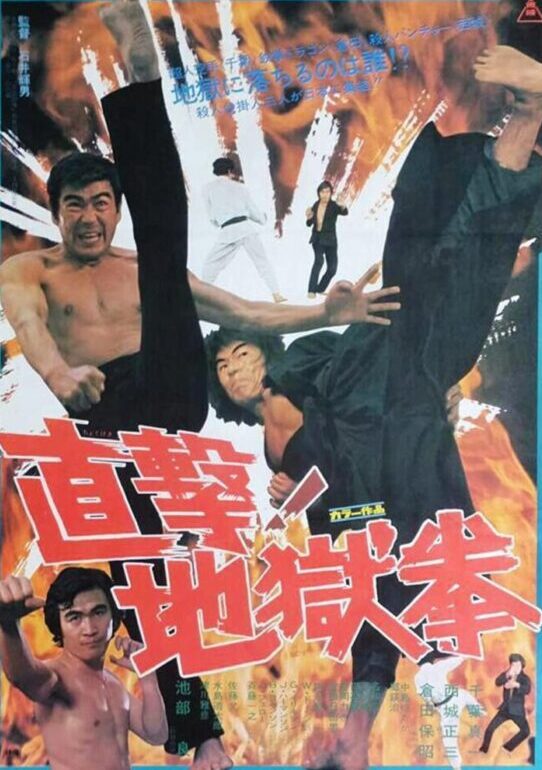
Ex-police commissioner Arashiyama and his niece Emi want to bust a Mafia drug ring which is beginning to flood Japan with their goods. Because the most visible member of the gang is the Latin American [country unspecified] ambassador’s wife, it’s hard to touch this group by legal means. So Arashiyama decides to hire three men to take them out; skilled ninja who just about makes a living as a second-rate private detective Koga; disgraced police officer turned free-lance assassin Takeshi Hayabusa; and petty crook and aikido expert Sakura whom Koga has to break out of prison. They first have to interrupted an exchange and grab a case of drugs, but how can they succeed when they keep arguing and even fighting among themselves….
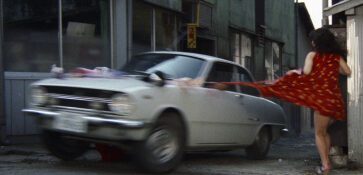
Twice in The Executioner we’re told that “The Way of the Ninja is the bringing together of superhuman intellect and indomitable spirit through years of discipline”, which might sound as if this film is a serious look at the subject, but we also have a scene where a dying bad guy says “Take care of my car payments” before expiring, surely one of the strangest last few words on film, so you’ll know that there’s also a lot of humour. In fact overall silliness mostly dominates in this really rather strange but immensely entertaining romp which combines goofy [if often very un-PC but they didn’t care much about that in the ’70s, especially in the more exploitation arenas] laughs and brutal action to very good and not at all jarring effect. The plot is pretty minimalist – three not particularly good guys go out to get lots of bad guys who are spreading drugs – but it’s easy to see why Tarantino especially likes this one, what with the interplay between its well played main characters which is often pretty sharp. Well, I say “Well played” but Chiba is an acquired taste whom newcomers may not be sure about. His acting is extremely broad and he often fights like Bruce Lee [some of the mannerisms are extremely similar] on drugs, but boy does he have a lot of chemistry. Likewise, if you’re used to Hong Kong movie action, you may find the karate and ju-jitsu on offer to be a lot simpler [there’s a lot less acrobatics] and roughly choreographed – even the camera work is erratic and full of awkward compositions – but there’s a good enough variety in the brawls, and in the end this movie isn’t all about the fighting anyway.
Most opening credit sequences, if they showcase the main star, show him at a distance showing his expertise at the martial arts. This one just shows his arms, to a point where they’re almost fetishised, as they move around and are freeze framed. Arashiyama – yes, he’s played by Ryô Ikebe star of my favourite non-kaiju Toho science fiction fiction movie Battle In Outer Space! – recruits his three heavies to do the job that he can’t do legally. Koga is first shown as a boy played by none other than Hiroyuki Sanada being trained by his grandfather to jump over a bush, the final time with a sword sticking out of it. Then he gets him to disloclate his joints in a queasy moment; feet are easy but hands are more important. Why is Koga being put through all this? Because “It is the duty and the responsbility of the legitimate heir of the Koga clan”. Young Koga has understandably had enough of this and tries to sneak away at nighjt, but the always watchful [well he is a ninja] grandfather catches him and they train and fight some more, with grandfather throwing powder in his eyes so his other senses are stronger. Now we’re introduced to Hayabusa in a pair of scenes which deliberately seem to recall the first two scenes that introduce Lee Van Cleef’s Angel Eyes in The Good, The Bad And The Ugly, though with some sex added. Hayabusa kills the person he’s been hired to kill even though said person offered him money, because, much like Angel Eyes who says “I always see the job through”, he tells us “I always deliver, it’s my professional reputation”. Here though, the victim has a woman with him whom the killer then sleeps with, then offers him money to bump off the person who paid him to kill her husband. As for Sakura, he’s currently awaiting execution in a prison, so Arashiyama’s niece Emi gets Koga, who’s not really making it as a PI [ninja skills aren’t always that useful in the modern world] has to go and get him, but only if he can keep the drug money being smuggled in, cue a few spectacular if edited together and unbelievable leaps and kills.
They all sit down to watch film of the effects of drugs being smuggled in – influenced by a similar scene in Enter The Dragon? We get a rather confusing flashback which I think details Arashiyama’s first attempt to grab the lady who’s essentially the untouchable face of the Mafia [though sometimes we’re told Yakuza, it’s not entirely clear] which results in six cops getting killed. “You’re a disgrace to the police”, he’s told. The reply is “Not me, I was fired three years ago”. Sakura’s actually reluctant to go on this mission to go and get the bad guys, but Emi tells him that she’s like an octopus, referring to a line a few minutes earlier where Sakura describes a sexual fantasy involving a woman behaving like an octopus. So Sakura is now ready to go, though he can’t stop perving at Emi whenever he has the opportunity, in moments that may not be considered amusing by some today, though it’s important to note that Emi takes it all in her stride and even laughs at times. She’s playing him. Our heroic trio first have to grab a case of drugs. After some staking out and stalking around in a restuarant, Chiba gets his first proper fight and it’s a doozy. When the villains spill yellow and blue paint on the ground, Chiba leaves leaving yellow and blue footprints all over them as he kicks their asses – then rips a man’s rib from right out of his chest! This isn’t shown in closeup but is still quite startling. Sakura is supposed to pick him up in his car and keeps on slowing down but then drives away. What a funny guy! Still, they’ve hurt the bad guys, so have to carry on doing the same, but main bad guy Mario Mizuhara has brought in some super heavies; Leone of Sicily, Lone Wolf and Blazer Nashiyama, so their job could be harder than expected. Then again, some of these villains don’t seem to like each other much, but neither do Koga, Hayabushi and Sakura. Mind you, Koga is able to kill a dog [surprisingly restrained this moment], so things should be okay, shouldn’t they?
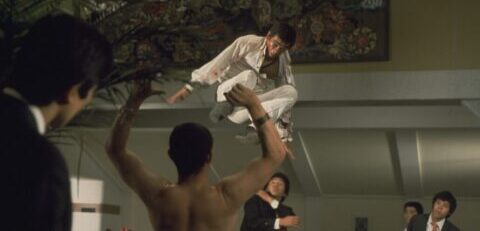
Even the relationship between the three is reminiscent of The Good, The Bad And The Ugly, and it helps that the chemistry between the three performers, and also Yukata Nakajima as Emi who’s often along for the ride, is great. All is resolved in a final reel crammed with brawling and more possible Sergio Leone referencing when Koga is beaten by laughing bad guys, here with the twist that the nasties are competing to see who can punch, throw, push or hurl him furthest, but this doesn’t stop him from showing off some really impressive rope nunchucku skills soon after. The two Caucasian wrestlers are defeated rather too easily, but then they clearly aren’t as great as they’re built up to be, which is probably the intention of course, while Chiba’s character, even though he’s able to punch people in the face so hard that eyeballs can pop out of their sockets or teeth can fall out, doesn’t really show much in the way of ninja skills except for sometimes hanging on the ceiling – oh, and a really funny moment where he interrupts a guy having sex and then uses his skills to hide under the sheets with her without the other man seeing him do so. The climax involves Chiba hanging off and climbing up a cliff while the grapple hook part of his rope is embedded in a bad guy. The final fight between him and Rikiya Yasuoka as Blazer Nashiyama is a bit of an anti-climax, not so much because it’s short – fights in Japanese films tend to be shorter anyway, the aim obviously being to kill your opponent[s] not play around with him / them – but because it’s filmed mostly in closeups and even seems to have some shots missing. One section is also quite obviously filmed on a set even though the rest of the fight takes place on location. Was the production rushed to meet a deadline? The camerawork isn’t always steady and sometimes settles on cluttered compositions, yet I shouldn’t complain too much, because there’s nothing that gets close to the incoherent, eye-hurting vomit-cam that was a common feature in modern action though which thankfully seems to be retreating.
Ikebe as Arashiyama is allowed some moments of gravitas which make you care about his character, but it’s really Makoto Sato as Hayabusa who’s given the main acting duties which he certainly pulls off. He’s also required to do some action despite obviously not being a trained martial artist; fortunately the editing and staging in these moments helps to sell us on Hayabusa’s prowess, and Sato has a strong enough presence for us to buy the character being so powerful. Yasuaki Kurata [or should that be Bruce Lo as that’s how he was billed a few times in the States?] shows up for two fights though his character is pretty pointless. Gô as Sakura hardly does any fighting and instead largely functions as the major, though certainly not the only, source of comic relief which is often very crude in nature. Whether he succeeds in this or not, in a film where a speeding car can pull some clothes hanging which is also able to pull a woman’s clothes off, will of course be up to the viewer; I was kept chucking, though admittedly this was partly because it would be unlikely for some of his moments to appear in a film today unless the character was not one we were supposed to like. Sometimes Eshii, who also wrote, seems to be mocking the idea of ninjas, such as when Koga hides in a swimming pool that’s about a two feet deep. There’s also a surprising emphasis on the unnamed blonde who’s the seemingly constantly high girlfriend / prisoner of the head of the gang. He slaps her about and publicly humiliates her, yet she’s always clinging on to him and kissing him, desperately craving affection. She’s a sad, pathetic character about which we want to know more. Also a character is Hajime Kaburagi’s funky music, which is about as ’70 as you can but is full of cool tracks which may not always go with what’s taking place on screen or seem to be trying to ramp up the excitement, but which helps the lightning pace to keep hurtling forward in a whirlwind of blows, blood, boobs, and cars racing around.
Quite openly wearing its influences on its sleeve yet as quintessentially a Japanese exploitation movie from the golden age of the form as you can get, The Executioner actually seems rather fresh and certainly doesn’t have a dull moment in its whole running time.
THE EXECUTIONER 2: KARATE INFERNO [1974]
AKA CHO KUGEKI JIGOKU-KEN: DAI-GYAKUTEN, DIRECT HIT KILL FIST: GREAT TURNABOUT
RUNNING TIME: 86 MINS
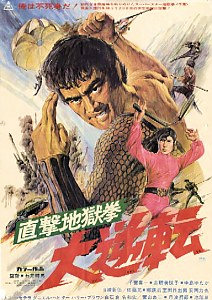
“We have an emergency, gather the three of them” says Arashiyama to his niece Emi. So Emi rounds up Ryuichi Koga, Takeshi Hayato and Ichiro Sakura. Heiress Sabin Kaufman has had the priceless Jewel of the Pharoahs stolen and her eight year old daughter kidnapped by crooks who demand one million yen, otherwise said daughter will be killed, and she’s asked Arashiyama to help. An exchange, the daughter and the jewel for the money, is set up, and Koga, Hayato and Sakura set out to disrupt it so that the money is also retrieved along with the daughter, but things go wrong and the jewel remains in the possession of the bad guys….
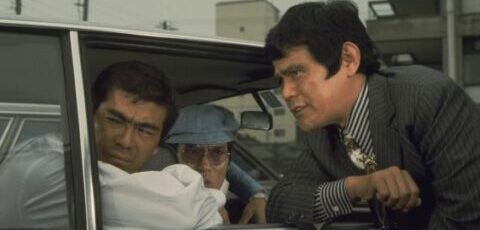
I did enjoy The Executioners: Karate Inferno, but there’s no doubt that it’s a significantly weaker effort than its predecessor. When an original film works so well, one would expect a sequel to be well crafted, the best way to go in my opinion being to give audiences more of what they liked while adding a few new elements. However, there have been quite a few instances where a sequel has been rushed out purely to make easy money, and that really looks like the case with this film. In addition to having two actors return playing different people, it reunites the five main characters from the first movie, and it’s great to see them all together again- all five performers play extremely well off each other. And that’s just as well, because there’s far less action and a hell of a lot of footage of the characters just goofing around or simply talking, the pace therefore being considerably slower. The increased amount of humour can’t help but induce a lot of laughs, but the screenwriters. Ishii being helped by Shinichi Hashimoto here, either seem to have forgotten some of the major reason as to why the first film worked so well [the title is misleading] or [this could be more likely] had to cobble something together quickly and cheaply with limited time and money. There’s a bit of graphic violence and sexual humour, but a lot of the comedy is as simple as you can get. When Sakura is cooking eggs and accidently lets them fly off the pan into the face of Hayabusa who then smears Sakura’s face with them before pouring tomato juice over him, one might wonder at what age group the filmmakers were aiming for, though I personally enjoy that kind of slapstick so it didn’t bother me. Many others will find it tiresome. Bogey, wee and dandruff are all used for comic effect; it’s a wonder that they didn’t cram in a poo joke. Meanwhile the plot, while it’s more complex than what we had before, is full of holes and the action, when it comes, is decent but decidedly inferior apart from some portions of a length heist sequence.
The opening titles are a montage of very quick shots from both films, which hardly gets us excited for the rest of the film. So what have our threesome been up to since the events of the last movie. Koga joined “the Rangers Unit of the Self Defence Forces” and is shown parachuting out of a plane in black and white so that a few stock shots don’t stick out too much. His boss asks him what the first rule of his position is, this being absolute secrecy, before informing him that he’s broken said rule because somebody has showed up to see him. This is, of course, Emi, for some reason wearing hugely excessive makeup yet it’s still obvious that it’s her. Koga isn’t too keen on going back out there, so Emmy tells him she’ll reveal secrets about his past [which we never learn] if he doesn’t play ball. Hayabusa is back to working as an assassin for hire again, though we don’t see this. He’s doesn’t want to work with Koga who he speaks poorly off, even considering his ceiling hanging as “retardisation”, but then a samurai figure comes to life and out of it bursts Koga who was there all along! They’re waiting for Sakura, but he may not come “because of a woman”. Apparently he was imprisoned for rape and safe-cracking but is now married to the woman he raped and is appealing his term as she’s fallen in love with him. She turns out to have a huge mole beside her nose. Ho ho ho? Probably not for many, at least these days, but if you’re watching this film then you probably know how un-PC things may get. These three aren’t enthused about having to work with each other again, and spend much time deliberately getting on each other’s nerves. In fact it takes a while for the main plot to be set in motion, but thankfully these guys and the one gal all share chemistry and lots of it.
As for said main plot, it’s introduced in a convoluted way, possibly to use up more screen time than it might have done otherwise. Film is shown of Sabine, who has to use a wheelchair, and the “Honorary Chairman of the International Philanthropic Organisation”. Koga, Hayabusa and Sakura think that they’re being asked to steal from said philanthropic organisation which goes against their somewhat limited principles, but then we get a flashback to Arashiyama being told about the theft of the necklace and the kidnapping of Sabine’s daughter, then a flashback within a flashback of Sabine getting her phone call from the bad guys, then a macabre doll with some of its hair cut off and a pin in one of its eyes which apparently signifies that the daughter will be killed if this money isn’t paid. Sabine’s secretary Bruno Imamura is to drop off the case full of money in return for the girl and the necklace, and our three have to get the suitcase back. There’s a rooftop exchange, then Koga pursues the guy who takes the case, but is intercepted by some heavies and our first action sequence takes place. In the end our heroes get neither the money nor the necklace and therefore don’t get paid, something that understandably irks them – and then Sabine makes a deal with the villains whereupon she will exchange one billion yen for the necklace. With the necklace now in Sabine’s possession, Koga decides to go and steal it without telling anybody else, but finds Sakura under the lady’s bed, though that’s probably nothing new for Sakura considering what he’s like. I shouldn’t be divulging all of the plot, but it’s weird in that it tries to surprise and gives the illusion of being well worked out for a few minutes until the huge gaps in logic become obvious. I guess time was again the problem here. Anyway, it all winds up with this big heist followed by an odd coda which finishes the proceedings on a slightly downbeat and rather incongruous. not to mention pointless, note.
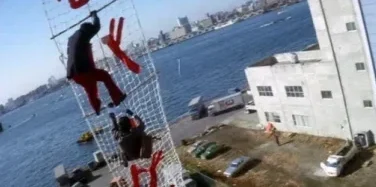
Koga, Hayabusa and Sakura bicker and mess around endlessly, and are pretty incompetent too, but then this film is set in a world where anyone could be a fool, right down to a guy who drops his glasses and therefore can’t see anyone and thinks that people are in a totally different place to where they actually are. Any excuse for a laugh is put in. Our three go to a posh restaurant and have no idea what to do, including thinking that the serviettes are there for them to put on their heads. Powerful glue needed for the heist results in someone being stuck to a table by their hand. Dandruff is put in a drink and is retaliated with by snot put in the other person’s drink. Koga is hanging outside of a high-rise building and a bikini-clad woman leans out of the window with her enormous breasts hanging over his head. Sakura’s body catches fire and Koga doesn’t see much urgency in the problem until he eventually puts out the fire with his urine, which is something I believe would have been the best course of action anyway. This isn’t the first wee wee gag in the film. With so much comedy, I think every viewer is bound to laugh a few times, and that’s good, because the action content really isn’t very high. The rooftop fight after the exchange is almost ruined by excessive shakycam and quickly changes into Bond-style stuff as Koga and his quarry end up hanging onto a balloon. A plane later goes through a tunnel which suggests that maybe the budget actually was bigger than I assumed. A final brawl, by contrast to the earlier one, has some interesting compositions that suggest Ishii and his cinematographer [uncredited] were trying to do the best they could despite being seriously restricted. The fighting is okay and Chiba gets to show off his rope nunchucku skills again but tends to repeat gags such as jumping up a fence in order to kick someone. Graphic violence makes a return here, most notably with teeth being knocked out followed by a heart ripping, but it almost seems out of place because we’ve got used to it not being present.
Ishii rises to the occasion in the heist sequence which had moments that are pretty suspenseful yet which are usually able to mix in the comedy without detracting from the tension – and ~I’m most certainly not just saying that because I really dig heist movies and set pieces. When Koga and Sakura are crawling upside down on a ceiling, the afore mentioned super strong glue being finally put to good use, it’s damned exciting and cool, and when the chuckles are brought in they aren’t intrusive. Now this may largely be because by now we’re used to having so much comedy in this movie, but I do think that, despite whatever flaws The Executioner 2 may have – and there are many – the balance is really well pulled off on some occasions. The many technical imperfections, most notably some absolutely atrocious rear projection in two scenes, can generally be laughed at even though the lady playing Sabine may be the worst actresses you will have seen in some time – but then this movie was clearly very cheap indeed. And at least Chiba,Sato and Go are just as good as before, if maybe even better as they’re clearly sinking into their roles. Ikebe has less to do here, and Yukata Nakajima’s Emi remains rather enigmatic; as well as being a character that we want to know more about, with Nakajma having such a screen presence that your attention can’t help but be drawn to her. Chiba seems slightly uneasy here, as if he knows that the film isn’t making the best use of his skills, though Gô appears to be having a ball because nearly everyone acts as silly as him at times. His interplay with Sato is simply terrific. If Toei had allowed more time and care be allotted to this sequel, then I have little doubt that it would have had a very good reception and been followed by a few more. It’s really a bit of a shame. Kaburagi’s musical score goes more for the comedy with lots of use of a synthesised whistle, but avoids reprising previous tracks and if anything goes with the visuals more than before.
The Executioner: Karate Inferno will disappoint many, yet if approached with the right mindset it’s a film that can still be enjoyed, especially if you’re in the mood for a giggle. I think my liking of of it may increaase with re-watches.
SPECIAL FEATURES
High Definition Bluray (1080p) presentation
Both films look extremely of their time but obviously made to look the best they can. Therefore there’s some softness in the picture, though some out of focus shots were clearly the result of a quick shooting schedule rather than any flaws in the restoration. Grain is extremely evenly managed and blacks are fairly deep.
Original uncompressed Japanese mono audio for both films
Original uncompressed English mono audio track for “The Executioner”
I watched some of the movie with this dub. It’s one of those ones where the voice actors attempt to sound Japanese, or should I say vaguely oriental. This would probably be considered insulting today, but no offense was obviously intended. It’s not bad really.
Optional English subtitles
Brand new audio commentary by Chris Poggiali and Marc Walkow
This track begins well with the identification of those rocks being splashed with water, the Toei logo. It then soon becomes apparent that there’s little production info on this film so Poggiali and Walkow have to say plentiful things about every performer on screen which can get slightly tiring when there’s so much fun and interesting stuff taking place on screen, but some good related info is revealed, such as Bob Shaye on New Line Pictures traveling to the Toei offices to find a good Yakuza film and, on the way out, spotted a poster for The Streetfighter, the release of which broke Chiba into the West. along with clarification of the Mafia / Yakuza issue and the identifying of a TV series named Key Hunter as the main inspiration. Poggiali and Walkow have good, if quite laid back, interplay and are there nice to spend time with.
Sonny Chiba, Karate King – a 30 minute featurette on the legendary Sonny Chiba, featuring Grady Hendrix, Tom Mes, Chris Poggiali, Marco Joachim and Seiji Anno, from the band Guitar Wolf [30 mins]
Chiba’s career and impact is looked at here. He originally wanted to be an Olympic gymnast, then become a clean cut matinnee idol before he transformed into a vicious screen hero who’s as much of an anti=hero. His aggressive and mannered performing style may have hid considerable insecurity about his acting. The comments of Grady Hendrix, the son of the editor of some of the American trailers for Chiba’s films, are especially interesting; he did a lot of the work himself. This could have done with being longer, but it will certainly whet your appetite for more Chiba if, like me, you haven’t had much experience with the man.
Original trailers
Image galleries for “The Executioner” and “The Executioner II: Karate Inferno”
Reversible sleeve featuring original and newly commissioned artwork by Lucas Peverill
FIRST PRESSING ONLY: Illustrated collector’s booklet featuring new writing on the films by by Mark Schilling
“The Executioner” is the most sheerly entertaining film I’ve seen in a while; the sequel isn’t anywhere in the same league but does have its pleasures. Though not as loaded with extras as we’ve come to expect from Arrow, the company make up for this by selling the one-disc release around the same price as they would any other single movie Blu-ray. Recommended!








Be the first to comment